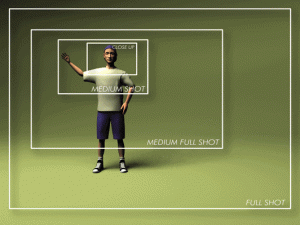Introduction
In Assignment 1.3, the writer must define a term from an academic field for an uninformed audience of the writers choosing. The objective is for the writer to communicate the moderately complex, discipline-specific term to the supposed group using three different technical forms of definition; parenthetical, sentence and expanded.
Reading Situation:
In this scenario, a professor is explaining the fundamentals of Film Studies to a group of First Year Film students. The technique that must be explained in this specific context is shot distance (AKA “Field size” or “camera-subject distance”).
Parenthetical definition
In a film scene, shot distance (viewers’ perceived distance from a film scene) is adjusted to signify the important visual components or meanings within the shot.
Sentence definition
Shot distance is a film technique typically characterised by the amount of screen space that is occupied by the subject of the scene which create a perceived sense of distance for the viewer.
Expanded definition
Analysis of Parts
Shot distance is separated into several types of shot, they are named for the sense of distance the viewer perceives from the framing of the shot.
- At farthest distance from the subject, this is known as an extreme long shot, the subject will appear minuscule and indistinct in comparison to the scale of the surrounding environment and landscape.
- When the subject appears distinguishable and the full, uncropped body of the subject is contained within the shot, this is referred to as a long shot.
- A medium shot crops out a portion of the lower body of the subject, typically establishing the torso and head of the subject as the focus of the shot.
- A close up focuses the frame of the shot around the head and very upper torso of the subject.
- An extreme close-up crops tightly around a specific part of the subject, typically a facial feature. With this framing, the viewer should expect to feel as if they situated incredibly close to subject.
Negation
Shot distance refers only to the perceived distance of the subject and does not pertain to the other compositional aspects such as the angle of a shot. Nor does shot distance pertain to any subsequent nor preceding movement of the camera such as horizontal or lateral movement of the camera, only to the relative screen space that the subject occupies within the frame of the shot.
Examples
Different shot distances create different meanings, the distance used in a shot will have typical uses that will occur many times throughout a film.
- A long or extreme long shot will try to place the character in a physical context, often used in establishing shots at the beginning of a scene to show where the scene is occurring.
- A medium shot will be used typically in dialogue scenes as this distance seems most comfortable to the viewer. This distance simulates the typical distance at which you would have a conversation with another person
- A close up will be used to highlight that a particular character is having a strong emotional moment. Focusing on the eyes or mouth of a subject will force the viewers attention to the non-verbal communication attempting to be portrayed by the subject.
Visual

This diagram clarifies how several levels of subject framing create the various shot distances. “Full shot” in this circumstance is synonymous with “long shot” and “medium full shot” is a more specified version of what could generally just be called a “medium shot”.
References:
Bowen, C. J., Thompson, R., Bowen, C. J. (2009). Grammar of the Shot. New York: Routledge.
Foust, J. C. (2018). Video production : Disciplines and techniques Routledge.
Mercado, G. (2010). The Filmmaker’s Eye. New York: Routledge.
Leave a Reply